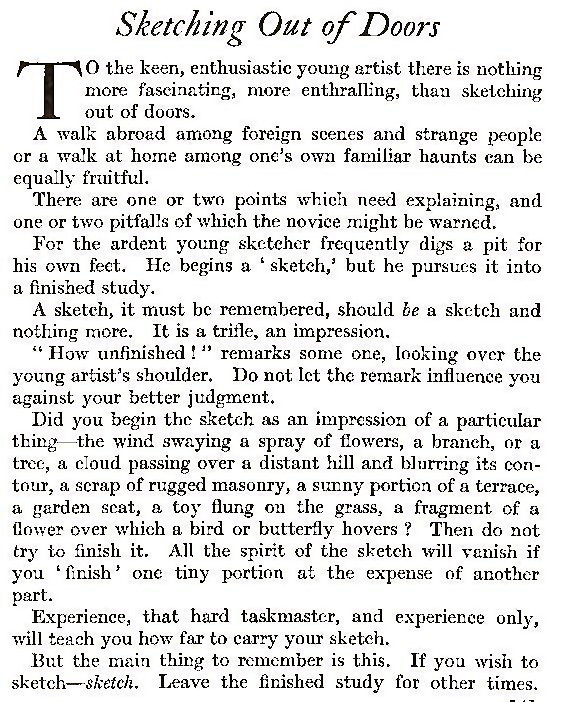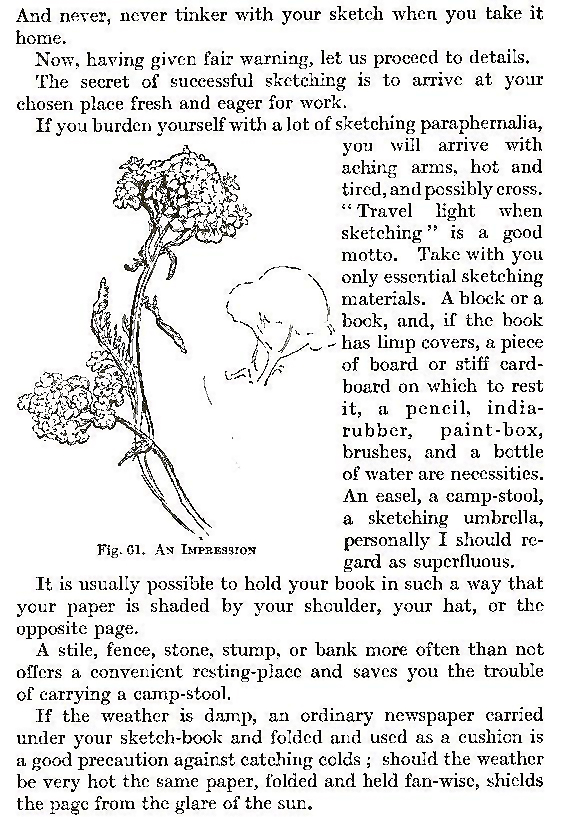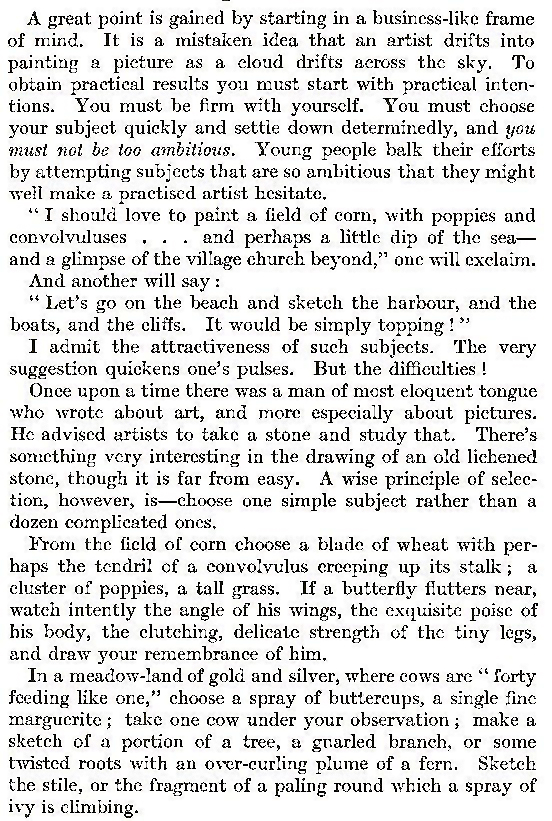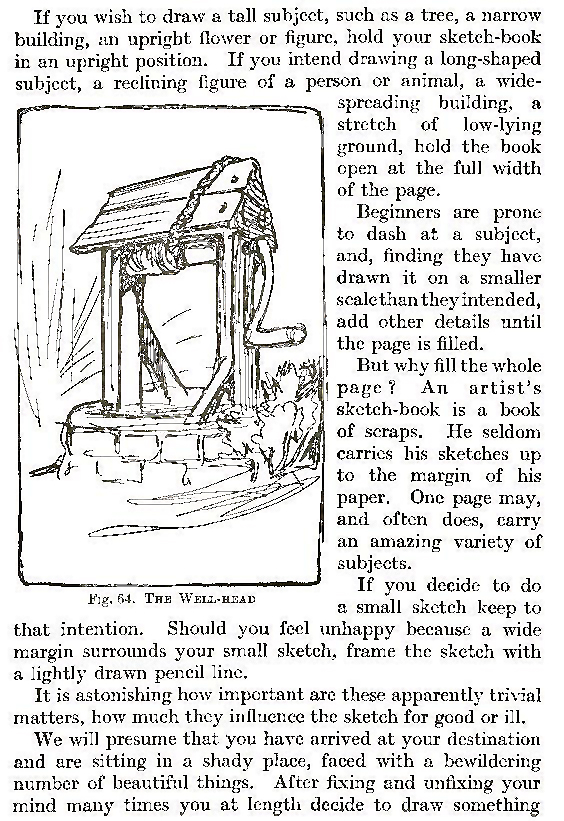Home > Drawing Directory Home> Drawing Nature > Drawing and Sketching Outdoors
DRAWING & sketching outside : How to draw nature outdoors with these lessons
|
GO BACK TO THE HOME PAGE FOR TUTORIALS FOR BEGINNING ARTISTS
[The above words are pictures of text, below is the actual text if you need to copy a paragraph or two]
SKETCHING AND DRAWING NATURE OUTDOORS / OUTSIDE
Sketching Out of Doors
To the keen, enthusiastic young artist there is nothing more fascinating, more enthralling, than sketching out of doors.
A walk abroad among foreign scenes and strange people or a walk at home among one's own familiar haunts can be equally fruitful.
There are one or two points which need explaining, and one or two pitfalls of which the novice might be warned.
For the ardent young sketcher frequently digs a pit for his own feet. He begins a ' sketch,' but he pursues it into a finished study.
A sketch, it must be remembered, should be a sketch and nothing more. It is a trifle, an impression.
"How unfinished!" remarks some one, looking over the young artist's shoulder. Do not let the remark influence you against your better judgment.
Did you begin the sketch as an impression of a particular thing—the wind swaying a spray of flowers, a branch, or a tree, a cloud passing over a distant hill and blurring its contour, a scrap of rugged masonry, a sunny portion of a terrace, a garden seat, a toy flung on the grass, a fragment of a flower over which a bird or butterfly hovers ? Then do not try to finish it. All the spirit of the sketch will vanish if you ' finish ' one tiny portion at the expense of another part.
Experience, that hard taskmaster, and experience only, will teach you how far to carry your sketch.
But the main thing to remember is this. If you wish to sketch—sketch. Leave the finished study for other times.
And never, never tinker with your sketch when you take it home.
Nov, having given fair warning, let us proceed to details. The secret of successful sketching is to arrive at your chosen place fresh and eager for work.
If you burden yourself with a lot of sketching paraphernalia, you will arrive with aching arms, hot and tired, and possibly cross. " Travel light when sketching " is a good motto. Take with you -- only essential sketching materials. A block or a book, and, if the book- has limp covers, a pieceof board or stiff cardboard on which to rest rubber, paint-box, brushes, and a bottle of water are necessities. An easel, a camp-stool, a sketching umbrella, personally I should regard as superfluous.
It is usually possible to hold your book in such a way that your paper is shaded by your shoulder, your hat, or the opposite page.
A stile, fence, stone, stump, or bank more often than not offers a convenient resting-place and saves you the trouble of carrying a camp-stool.
If the weather is damp, an ordinary newspaper carried under your sketch-book and folded and used as a cushion is a good precaution against catching colds ; should the weather be very hot the same paper, folded and held fan-wise, shields the page from the glare of the sun.
Fig. 61. AN IMPRESSION
A great point is gained by starting in a business-like frame of mind. It is a mistaken idea that an artist drifts into painting a picture as a cloud drifts across the sky. To obtain practical results you must start with practical intentions. You must be firm with yourself. You must choose your subject quickly and settle down determinedly, and you must not be too ambitious. Young people balk their efforts by attempting subjects that are so ambitious that they might well make a practised artist hesitate.
" I should love to paint a field of corn, with poppies and convolvuluses . . . and perhaps a little dip of the sea—and a glimpse of the village church beyond," one will exclaim.
And another will say :
" Let's go on the beach and sketch the harbour, and the boats, and the cliffs. It would be simply topping! "
I admit the attractiveness of such subjects. The very suggestion quickens one's pulses. But the difficulties!
Once upon a time there was a man of most eloquent tongue who wrote about art, and more especially about pictures. He advised artists to take a stone and study that. There's something very interesting in the drawing of an old lichened stone, though it is far from easy. A wise principle of selection, however, is—choose one simple subject rather than a dozen complicated ones.
From the field of corn choose a blade of wheat with perhaps the tendril of a convolvulus creeping up its stalk ; a cluster of poppies, a tall grass. If a butterfly flutters near, watch intently the angle of his wings, the exquisite poise of his body, the clutching, delicate strength of the tiny legs, and draw your remembrance of him.
In a meadow-land of gold and silver, where cows are " forty feeding like one," choose a spray of buttercups, a single fine marguerite ; take one cow under your observation ; make a sketch of a portion of a tree, a gnarled branch, or some twisted roots with an over-curling plume of a fern. Sketch the stile, or the fragment of a paling round which a spray of ivy is climbing.
Should you wish to sketch a cottage, be careful not to sit too near. If you do, your perspective will be very violent and look exaggerated. Sit half a meadow away rather than at the front gate.
Fig. 62. WHEN SKETCHING A COTTAGE DO NOT SIT TOO NEAR.
And if the cottage is complicated (that is, filled with detail, the thatch deep and overhanging, the creepers thick and concealing the shape of the wall, and the little lattice-windows nearly hidden from view), draw a portion of the cottage—a corner of the eaves and one window, a portion of the roof and the queer old chimney, the porch with its potted plants and window-seat, or the well-head with its dripping rope and shining pail. And a word of advice about a garden. There is nothing more difficult than garden scenes. The subjects are many, the lights are often broken, the shadows are confused. Content yourself with a woodshed, or portion of a summer-house, a few mossy steps, a garden roller, a corner of the terrace, a wheelbarrow, or a cluster of pots and a trowel.
At the outset ask yourself whether the object you intend to draw will best fit an oblong or upright sheet of paper.
If you wish to draw a tall subject, such as a tree, a narrow building, an upright flower or figure, hold your sketch-book in an upright position. If you intend drawing a long-shaped subject, a reclining figure of a person or animal, a widespreading building, a stretch of low-lying ground, hold the book open at the full width of the page.
Beginners are prone to dash at a subject, and, finding they have drawn it on a smaller scale than they intended, add other details until the page is filled.
But why fill the whole page? An artist's sketch-book is a book of scraps. He seldom carries his sketches up to the margin of his paper. One page may, jand often does, carry an amazing variety of subjects. If you decide to do a small sketch keep to that intention. Should you feel unhappy because a wide margin surrounds your small sketch, frame the sketch with a lightly drawn pencil line.
It is astonishing how important are these apparently trivial matters, how much they influence the sketch for good or ill.
We will presume that you have arrived at your destination and are sitting in a shady place, faced with a bewildering number of beautiful things. After fixing and unfixing your mind many times you at length decide to draw something.
Privacy Policy ..... Contact Us











